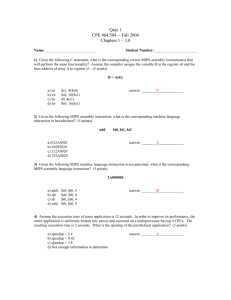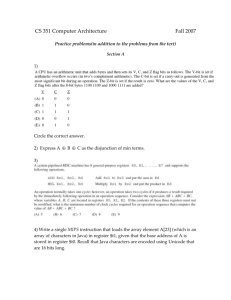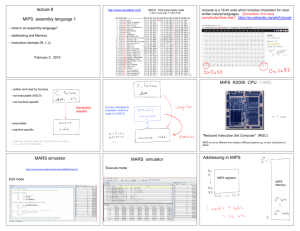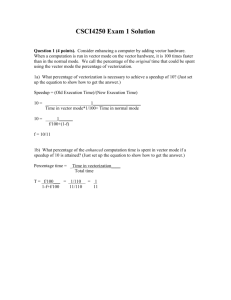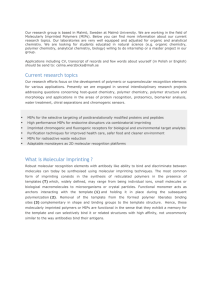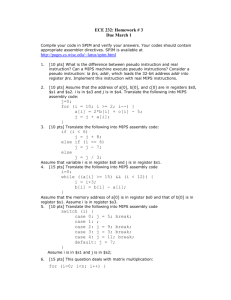MIPS Instruction Set Architecture
advertisement
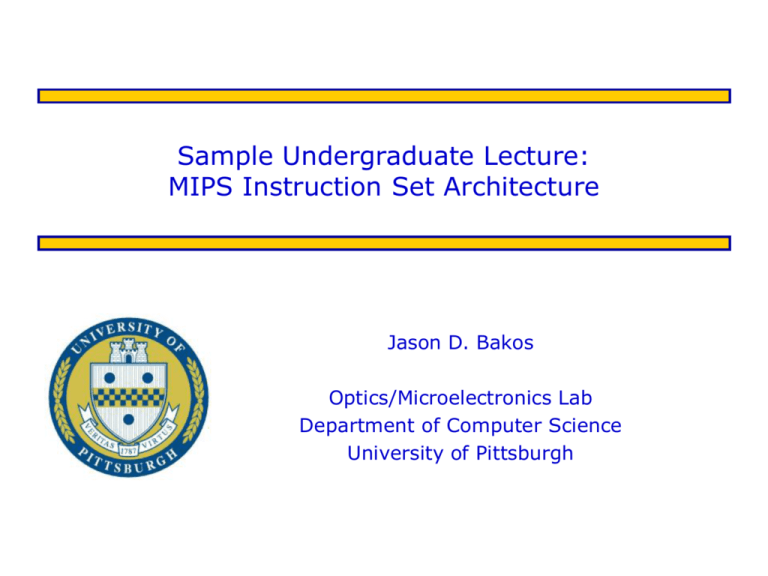
Sample Undergraduate Lecture: MIPS Instruction Set Architecture Jason D. Bakos Optics/Microelectronics Lab Department of Computer Science University of Pittsburgh Outline • Instruction Set Architecture • MIPS ISA – Instruction set – Instruction encoding/representation – Example code • Pipelining – Concepts – Hazards • Pipeline enhancements: performance University of Pittsburgh MIPS Instruction Set Architecture 2 Instruction Set Architecture • Instruction Set Architecture (ISA) – Usually defines a “family” of microprocessors • Examples: Intel x86 (IA32), Sun Sparc, DEC Alpha, IBM/360, IBM PowerPC, M68K, DEC VAX – Formally, it defines the interface between a user and a microprocessor • ISA includes: – Instruction set – Rules for using instructions • Mnemonics, functionality, addressing modes – Instruction encoding • ISA is a form of abstraction – Low-level details of microprocessor are “invisible” to user University of Pittsburgh MIPS Instruction Set Architecture 3 Instruction Set Architecture • ISA => abstraction is a misnomer • Many processor implementation details are revealed through ISA • Example: – Motorola 6800 / Intel 8085 (1970s) • 1-address architecture: • (A) = (A) + (addr) ADDA <addr> – Intel x86 (1980s) • 2-address architecture: • (A) = (A) + (B) ADD EAX, EBX – MIPS (1990s) • 3-address architecture: • ($2) = ($3) + ($4) ADD $2, $3, $4 – Advancements in fabrication technology University of Pittsburgh MIPS Instruction Set Architecture 4 MIPS Architecture • Design “philosophies” for ISAs: RISC vs. CISC • Execution time = – instructions per program * cycles per instruction * seconds per cycle • MIPS is implementation of a RISC architecture • MIPS R2000 ISA – Designed for use with high-level programming languages • small set of instructions and addressing modes, easy for compilers – Minimize/balance amount of work (computation and data flow) per instruction • allows for parallel execution – Load-store machine • large register set, minimize main memory access – fixed instruction width (32-bits), small set of uniform instruction encodings • minimize control complexity, allow for more registers University of Pittsburgh MIPS Instruction Set Architecture 5 MIPS Instructions • MIPS instructions fall into 5 classes: – – – – Arithmetic/logical/shift/comparison Control instructions (branch and jump) Load/store Other (exception, register movement to/from GP registers, etc.) • Three instruction encoding formats: – R-type (6-bit opcode, 5-bit rs, 5-bit rt, 5-bit rd, 5-bit shamt, 6-bit function code) – I-type (6-bit opcode, 5-bit rs, 5-bit rt, 16-bit immediate) – J-type (6-bit opcode, 26-bit pseudo-direct address) University of Pittsburgh MIPS Instruction Set Architecture 6 MIPS Addressing Modes • MIPS addresses register operands using 5-bit field – Example: ADD $2, $3, $4 • MIPS addresses branch targets as signed instruction offset – – – – relative to next instruction (“PC relative”) in units of instructions (words) held in 16-bit offset in I-type Example: BEQ $2, $3, 12 • Immediate addressing – Operand is help as constant (literal) in instruction word – Example: ADDI $2, $3, 64 University of Pittsburgh MIPS Instruction Set Architecture 7 MIPS Addressing Modes (con’t) • MIPS addresses jump targets as register content or 26-bit “pseudo-direct” address – Example: JR $31, J 128 • MIPS addresses load/store locations – base register + 16-bit signed offset (byte addressed) • Example: LW $2, 128($3) – 16-bit direct address (base register is 0) • Example: LW $2, 4092($0) – indirect (offset is 0) • Example: LW $2, 0($4) University of Pittsburgh MIPS Instruction Set Architecture 8 Example Instructions • ADD $2, $3, $4 – R-type A/L/S/C instruction – Opcode is 0’s, rd=2, rs=3, rt=4, func=000010 – 000000 00011 00100 00010 00000 000010 • JALR $3 – R-type jump instruction – Opcode is 0’s, rs=3, rt=0, rd=31 (by default), func=001001 – 000000 00011 00000 11111 00000 001001 • ADDI $2, $3, 12 – I-type A/L/S/C instruction – Opcode is 001000, rs=3, rt=2, imm=12 – 001000 00011 00010 0000000000001100 University of Pittsburgh MIPS Instruction Set Architecture 9 Example Instructions • BEQ $3, $4, 4 – I-type conditional branch instruction – Opcode is 000100, rs=00011, rt=00100, imm=4 (skips next 4 instructions) – 000100 00011 00100 0000000000000100 • SW $2, 128($3) – I-type memory address instruction – Opcode is 101011, rs=00011, rt=00010, imm=0000000010000000 – 101011 00011 00010 0000000010000000 • J 128 – J-type pseudodirect jump instruction – Opcode is 000010, 26-bit pseudodirect address is 128/4 = 32 – 000010 00000000000000000000100000 University of Pittsburgh MIPS Instruction Set Architecture 10 Pseudoinstructions • Some MIPS instructions don’t have direct hardware implementations – Ex: abs $2, $3 • Resolved to: – – – – – bgez $3, pos sub $2, $0, $3 j out pos: add $2, $0, $3 out: … – Ex: rol $2, $3, $4 • Resolved to: – – – – – addi $1, $0, 32 sub $1, $1, $4 srlv $1, $3, $1 sllv $2, $3, $4 or $2, $2, $1 University of Pittsburgh MIPS Instruction Set Architecture 11 MIPS Code Example for (i=0;i<n;i++) a[i]=b[i]+10; loop: xor $2,$2,$2 lw $3,n sll $3,$3,2 li $4,a li $5,b add $6,$5,$2 lw $7,0($6) addi $7,$7,10 add $6,$4,$2 sw $7,0($6) addi $2,$2,4 blt $2,$3,loop University of Pittsburgh # # # # # # # # # # # # zero out index register (i) load iteration limit multiply by 4 (words) get address of a (assume < 216) get address of b (assume < 216) compute address of b[i] load b[i] compute b[i]=b[i]+10 compute address of a[i] store into a[i] increment i loop if post-test succeeds MIPS Instruction Set Architecture 12 Pipeline Implementation • Idea: – – – – – – – – Goal of MIPS: CPI <= 1 Some instructions take longer to execute than others Don’t want cycle time to depend on slowest instruction Want 100% hardware utilization Split execution of each instruction into several, balanced “stages” Each stage is a block of combinational logic Latency of each stage fits within 1 clock cycle Insert registers between each pipeline stage to hold intermediate results – Execute each of these steps in parallel for a sequence of instructions – “Assembly line” • This is called pipelining University of Pittsburgh MIPS Instruction Set Architecture 13 MIPS ISA • MIPS pipeline stages – Fetch (F) • read next instruction from memory, increment address counter • assume 1 cycle to access memory – Decode (D) • read register operands, resolve instruction in control signals, compute branch target – Execute (E) • execute arithmetic/resolve branches – Memory (M) • perform load/store accesses to memory, take branches • assume 1 cycle to access memory – Write back (W) • write arithmetic results to register file University of Pittsburgh MIPS Instruction Set Architecture 14 Hazards • Hazards are data flow problems that arise as a result of pipelining – Limits the amount of parallelism, sometimes induces “penalties” that prevent one instruction per clock cycle – Structural hazards • Two operations require a single piece of hardware • Structural hazards can be overcome by adding additional hardware – Control hazards • Conditional control instructions are not resolved until late in the pipeline, requiring subsequent instruction fetches to be predicted – Flushed if prediction does not hold (make sure no state change) • Branch hazards can use dynamic prediction/speculation, branch delay slot – Data hazards • Instruction from one pipeline stage is “dependant” of data computed in another pipeline stage University of Pittsburgh MIPS Instruction Set Architecture 15 Hazards • Data hazards – Register values “read” in decode, written during write-back • RAW hazard occurs when dependent inst. separated by less than 2 slots • Examples: – – – – ADD $2,$X,$X (E) ADD $X,$2,$X (D) … … ADD $2,$X,$X (M) … ADD $X,$2,$X (D) … ADD $2,$3,$4 (W) … … ADD $X,$2,$3 (D) – In most cases, data generated in same stage as data is required (EX) • Data forwarding – – – – ADD $2,$X,$X (M) ADD $X,$2,$X (E) … … University of Pittsburgh ADD $2,$X,$X (W) … ADD $X,$2,$X (E) … ADD $2,$3,$4 (out-of-pipe) … … ADD $X,$2,$3 (E) MIPS Instruction Set Architecture 16 “Load” Hazards • Stalls required when data is not produced in same stage as it is needed for a subsequent instruction – Example: • LW $2, 0($X) • ADD $X, $2 (M) (E) • When this occurs, insert a “bubble” into EX state, stall F and D • LW $2, 0($X) (W) • NOOP (M) • ADD $X, $2 (E) – Forward from W to E University of Pittsburgh MIPS Instruction Set Architecture 17 Pipelined Architecture fetch University of Pittsburgh decode execute memory MIPS Instruction Set Architecture write back 18 Example add $6,$5,$2 1 2 F D E F lw $7,0($6) addi $7,$7,10 add $6,$4,$2 3 4 5 6 7 8 D E M W F E M W addi $2,$2,4 blt $2,$3,loop 11 12 13 14 15 M W D F D E M F sw $7,0($6) 9 10 W D E M F W D E M F W D E M add $6,$5,$2 F W D E M W 8 instructions, 15 - 4 cycles, CPI = .73 University of Pittsburgh MIPS Instruction Set Architecture 19 Pipeline Enhancements • Assume we add branch predictor – Branch predictor success rate = 85% – Penalty for bad prediction = 3 cycles – Profiler tells us that 10% of instructions executed are branches – Branch speedup • = (cycles before enhancement) / (cycles after enhancement) • = 3 / [.15(3) + .85(1)] = 2.3 – Amdahl’s Law: Speedup 1 1 Fractionenhanced Fractionenhanced Speedupenhanced – Speedup = 1 / (.90 + .10/2.3) = 1.06 – 6% improvement University of Pittsburgh MIPS Instruction Set Architecture 20 Summary • Instruction Set Architecture – ISA is revealing (fabrication technology, architectural implementation) – MIPS ISA • Pipelining – Pipeline concepts – Hazards – Example University of Pittsburgh MIPS Instruction Set Architecture 21
